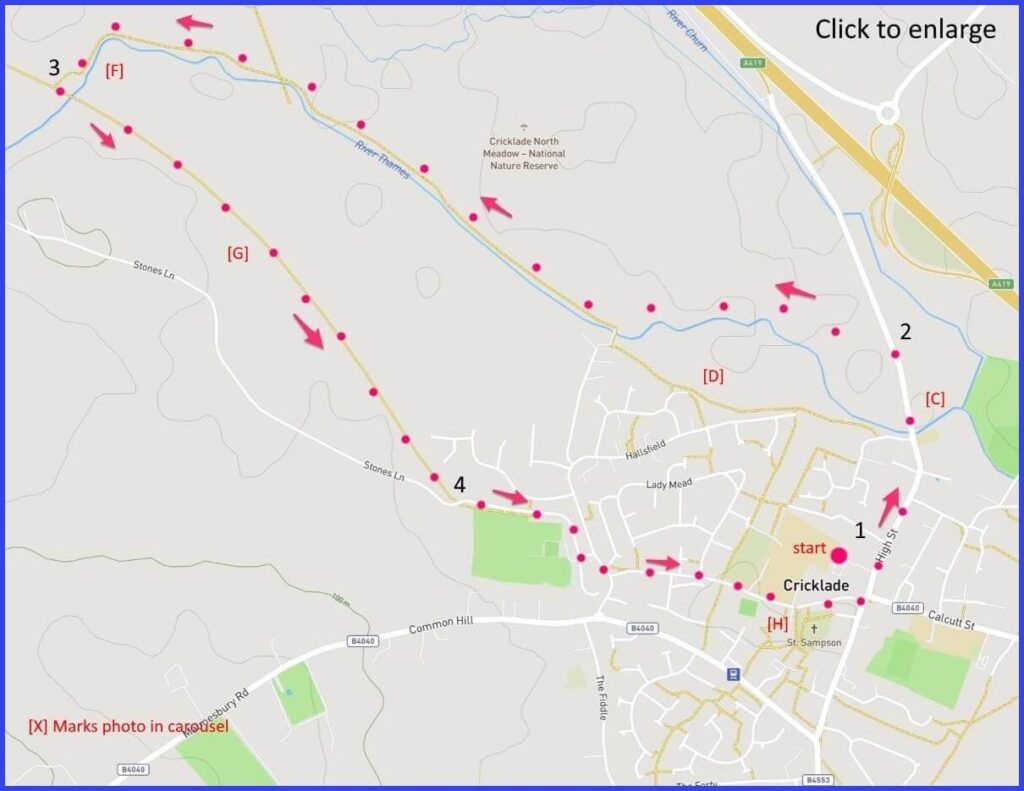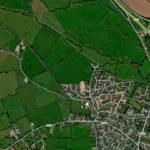SN6 6AY A level walk around Crickdale : a town-with-history, fairly rough fields, and a bridleway. All about 3.5 miles. Bonus in April/May. (Click map to enlarge. Click here to see arial view). Click here to download/print PDF. (There is a GPX route option here for phone/tablet download. But only follow this link after watching this GPX help video). Friendly warning: all files relating to walks are published here on good faith but on the understanding that users must be responsible for their own safety and wellbeing.
(Routes from map points + metres to next point)
1: Walk from car park Turn left on the high street and walk towards St Marys Church (picture B). Continue, crossing the Thames and towards speed limit signs. 575m
2: Enter field just after speed limit signs but before a bridge over this road. Follow a roughly marked route (E) that parallels the river towards a bridge. 1.2km
3: Step up to the bridleway some yards to the right of the river-crossing bridge (F). Follow the bridleway (G) back towards the town until path becomes a lane. 530m
4:Join Stones Lane, turn left on a short passage to West Mill Lane. Then turn left again when shortly reaching Bath Road. This take you to the church of St Sampson and from there to your start. 1.3km
The pictures below are in the order things were seen on this walk. Clicking on any one will enlarge it (and the slideshow)
The walk
There is parking (free) off the High Street. The route lets you start by exploring this small, once-important area. It leaves the street and follows a field path that crosses the river and picks up a bridleway back into Cricklade. Although it is celebrated as a well-preserved Saxon town, research suggests still older – Roman bricks were found in St Marys church during Victorian restoration. Sensing the town’s history is one reason for this walk: crossing its North Meadow is the other (Cricklade’s moto: “in loco delicioso“)
A Saxon town
The Saxon importance of this town reflects its position on the ancient border of Mercia and Wessex; specifically at the point where the Thames met the Ermin Way (Silchester to Cirencester, not the London-York ‘Ermine Street’!). Indeed “lade” means crossing point (here, at a hill). Being the first town on the Thames and an inland port may have been useful, but in Saxon times it also meant unwelcome visits from the shallow boats of marauding Vikings. Although Wiltshire has no coastline, that did not mean it was protected from Viking raids.
King Alfred (849-899) confronted such hit-and-run threats by constructing a network of fortified towns in this area: safe places for retreat when threatened by invading Danes. (Somewhat neutralised by all the castles that William the Conqueror built shortly after.) But Cricklade was one of those fortified towns (“burhs”) – not simply a fort, a commercial authenticity was also established. Nearby stone, gravel and fertile land also explain its early importance. The High Street up which you walk ran through the very middle of the 500-yard square area of Saxon defence. (Nevertheless, King Canute did manage to thoroughly plunder it in 1016 with a force of 160 longships).
In 928 King Athelstan insisted that Royal Mints should be situated in fortified places. For a short period (979 – 1100), Cricklade was one of these. This would have stimulated markets and may have contributed to the growth of other towns, those more exclusively marketing centres rather than part of fortifications. Thereafter Crickdale’s fortunes declined into the Middle Ages. It does still remain one of 30 Manorial Courts (created originally for dealing with minor local offences). Although now its duties are merely ceremonial – in particular, “management of the common lands of Cricklade” , including management of the grazing on North Meadow National Nature Reserve (more on which below).
Nevertheless the town has two notable churches. The Anglican parish church (pic H) is dedicated to St Sampson, the Cornish-Breton who some claimed taught here briefly (visit it towards the end of your walk perhaps). The church’s most striking feature is its 16th century crossing tower (pic I) – realised to cathedral proportions. Although Pevsner choses to describe it rather harshly: “proud and self-certain somewhat heavy and certainly not elegant”. The other church is basically Norman: Catholic St Marys, (pic B) which you pass on the right when first walking down the High Street (located close to those Saxon northern ramparts). Look in one of the windows (the building will probably be locked) – the visible high sided box pews don’t suggest a Catholic denomination, but then it was purchased from the Anglicans in 1984 on a 99-year lease.
A famous meadow
After its Saxon importance, the North Meadow is Cricklade’s other marker of distinction. It is a water meadow and so winter flooding passes nutrient minerals over the ground. A careful seasonal management pattern has been protected for centuries. This meadow has thereby been designated a Site of Special Scientific Interest, because it hosts around 80% of Britain’s snakeshead fritillaries. A magnificent site during April and May no doubt, although at any other time of the year it’s a rather flat and uninteresting piece of land (pic D: albeit still facilitating your pleasant walk). These famous blooms are not so rare as local publicity suggests – they are increasingly cultivated domestically and there are other places where they can be enjoyed. However the fritillaries are certainly a fine thing (much portrayed by Rennie Mackintosh for instance). Seeing them in abundance would be a great reward for a Cricklade visit – if carefully timed that is.
The off-street part of your walk starts in the meadow area, taking you down the abandoned line of the old railway (pic G), and then to Bath Road (once the main road from Oxford). This road re-joins the High Street; although now you are at south end, where you can admire the 1897 cast iron Jubilee clock – outside the Vale Hotel – paid for by the locals to celebrate Queen Victoria’s long reign. This and other establishments nearby might serve for refreshment: nowadays they thrive on the “Gateway to the Cotswolds” motto of Cricklade business.



![[A]](https://wiltshirewalks.com/wp-content/uploads/2021/10/01crick-150x150.jpg)
![[B]](https://wiltshirewalks.com/wp-content/uploads/2021/10/02crick-150x150.jpg)
![[C]](https://wiltshirewalks.com/wp-content/uploads/2021/10/03crick-150x150.jpg)
![[D]](https://wiltshirewalks.com/wp-content/uploads/2021/10/04crick-150x150.jpg)
![[E]](https://wiltshirewalks.com/wp-content/uploads/2021/10/05crick-150x150.jpg)
![[F]](https://wiltshirewalks.com/wp-content/uploads/2021/10/06crick-150x150.jpg)
![[G]](https://wiltshirewalks.com/wp-content/uploads/2021/10/07crick-150x150.jpg)
![[H]](https://wiltshirewalks.com/wp-content/uploads/2021/10/08crick-150x150.jpg)
![[I]](https://wiltshirewalks.com/wp-content/uploads/2021/10/09crick-150x150.jpg)